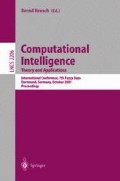Abstract
Learning fuzzy rule-based systems can lead to very useful descriptions of several problems. Many different alternative descriptions can be generated. In many cases, a simple rule base similar to rule bases designed by humans are preferable since it has a higher possibility of being valid in uniforseen cases. Thus, the main idea of this paper is to define a minimal cost function and to generate minimal knowledge bases. Furthermore, this paper shows similarities between the generationof fuzzy systems and the generation of boolean functions on the base of minimal cost functions and it proposes criteria to learn human reasoning fuzzy rules.
Access this chapter
Tax calculation will be finalised at checkout
Purchases are for personal use only
Preview
Unable to display preview. Download preview PDF.
References
S. K. Halgamuge and M. Glesner, “A fuzzy-neural approach for pattern classification with the generation of rules based on supervised learning,” in Neural Networks & their Applications: Proceedings of Neuro-Nimes’ 92, pp. 165–173, 1992.
F. Hoffmann. “Soft computing techniques for the design of the design of mobile robot behaviors,” Information Sciences, vol. 122, no. 2–4, pp. 241–258, 2000.
M. Krabs and H. Kiendl, “Entwurkskonzept für Fuzzy-Regler mit automatisch generierten Regelsätzen,” VDE-Fachtagung: “Technische Anwendungen von Fuzzy-Systemen”, Dortmund, 1992.
F. Cheong and R. Lai, “Constraining the optimization of a fuzzy logic controller using an enhanced genetic algorithm,” IEEE Transaction on systems, man and cybernetics — part B: Cybernetics., vol. 30, pp. 31–46, February 2000.
L. Castillo, A. Gonzalez, and R. Perez, “Includinga simplicity criterin in the selection of the best rule in a genetic fuzzy learning algorithm,” Fuzzy Sets and Systems, vol. 120, pp. 309–321, 2001.
H. Surmann and M. Maniadakis, “Learning feed-forward and recurrent fuzzy systems: a genetic approach,” Journal of Systems Architecture, Special issue on evolutionary computing, vol. 47, no. 7, pp. 535–556, 2001.
O. Cordon, F. Herrera, and M. Lozano, “On the bidirectional integration of genetic algorithms and fuzzy logic,” http://www.bioele.nuee.nagoya-u.ac.jp/wec2/papers/p003.html, 1996.
T. Takagi and M. Sugeno, “Fuzzy identification of systems and its application to modelling and control,” IEEE Transaction System Man and Cyberentic, pp. 116–132, 1985.
S.-T. Song and L.-H. Sheen. “Heuristic fuzzy-neuro network and its application to reactive navigation of a mobile robot,” Fuzzy Sets and Systems, vol. 110, no. 3, pp. 331–340, 2000.
L. A. Zadeh, “Fuzzy sets,” Information and Control, vol. Vol. 8, pp. 338–353, 1965.
A. Kandell and S. C. Lee, Fuzzy Switching and Automata: Theory and Applications. New York: Crane Russa, 1979.
H. Surmann and A. P. Ungering, “Fuzzyn-rule-based systems on general purpose processors,” IEEE MICRO, Special issue on fuzzy systems, pp. 40–48, Aug. 1995.
L.-X. Wang, “Fuzzy systems are universal approximators,” in First IEEE International Conference on Fuzzy Systems, San Diego, pp. 1163–1170, 8.-12.03.1992.
J. Buckley, “Sugeno Type Controllers are Universal Fuzzy Controller,” Fuzzy Sets and Systems, vol. 53, pp. 299–304, 1993.
H. Surmann, Genetic Optimizing of Fuzzy Rule-Based Systems, vol. 8 of Studies in Fuzziness and Soft Computing, ch. Optimization of Fuzzy Controllers, pp. 389–402. Physica-Verlag, Sep. 1996.
A. Gonzalez and R. Perez, “Completeness and consistency conditions for learning fuzzy rules,” Fuzzy Sets and Systems, vol. 96, pp. 37–51, 1988.
Author information
Authors and Affiliations
Editor information
Editors and Affiliations
Rights and permissions
Copyright information
© 2001 Springer-Verlag Berlin Heidelberg
About this paper
Cite this paper
Surmann, H. (2001). About the Combination of Functional Approaches and Fuzzy Reasoning. In: Reusch, B. (eds) Computational Intelligence. Theory and Applications. Fuzzy Days 2001. Lecture Notes in Computer Science, vol 2206. Springer, Berlin, Heidelberg. https://doi.org/10.1007/3-540-45493-4_78
Download citation
DOI: https://doi.org/10.1007/3-540-45493-4_78
Published:
Publisher Name: Springer, Berlin, Heidelberg
Print ISBN: 978-3-540-42732-2
Online ISBN: 978-3-540-45493-9
eBook Packages: Springer Book Archive

